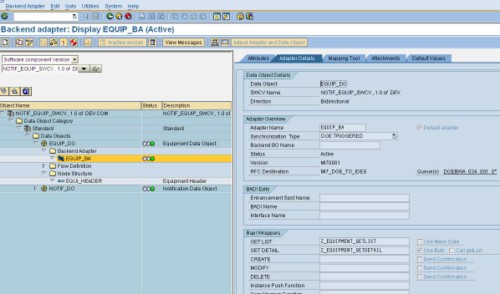Importing BAPI Wrappers as Data Objects:
Creation of SWCV:
What is an SWCV: SWCV Stands for Software Component Version.
A software component version is a shipment unit for design objects in the Data Orchestration Engine.
By the use of SWCV we can Define Data Model and Data Distribution Logic.
SWCV Creation.
T-Code: SDOE_WB
Go to T-Code SDOE_WB

 "
"
Click on “CREATE SWCV” Button.
The following screen appears.
Enter the details such as
• Name of the SWCV
• Vendor
• Version
• Backend Destination
• Data Object Package
“SAVE” the details.
" 
GO BACK
TAKE THE CREATED SWCV AGAIN FROM T-CODE “SDOE_WB”
 "
"
Import the BAPI Wrappers as DATA OBJECTS
Data objects can be simply defined as data base tables which are automatically generated in the middleware by taking the structure of the BAPI Wrappers structures created in the Backend System(In our Case it is an R/3 System).
A data object can contain many table /structures according the header and item structures defined in the BAPI wrappers.
It is not mandatory that DO is to be created by the wizard(Import BAPI Wrappers as Data Objects).We can manually create Data Objects as Well.
 "
"
Wizard Opens to Create Data Objects and The Backend Adapter.
Enter the details to proceed such as the desired
Data Object Name,
Bakcned Adapter Name,Backend Destination(RFC Destination needs to be created already (from Middleware to the backend system).
Type of The Data Object (In our case it is standard)
The Direction of the data object (In our case its bi-directional- both download and upload of data from backend to middleware and vice-versa).
In our case, we can thake the notification and equipment (plant maintainence module) as an example.
Create Notification Data Object
 "
"
In the next screen, give details of the active relevant BAPI wrappers as shown below.
 "
"
Save the changes
Once the save is done,The created data object is listed under the SWCV tree as shown in the figure.
Enter the description of the data object.When the data object node is expanded the other details like backend adapters ,node structures will be displayed.

The Node structures will be as shown in the below figure.
Enter a suitable description for all the node structures.In our case ,we have a parent node and respective child nodes.(Notification header and item details)
 "
"
In Node Attributes tab,we can view the node attributes.We need to mark the backend key fields for the node strucures .This has to be done for all nodes.Atleast one backend key filed should be checked for a node structure.
 "
"
The backend adapter details will be displayed as follows:

The below screen shows the mapping between the node strucutre fields of the Data Object Mapped with the filed structures of the BAPI Wrappers.
Since the creation of Data Object was done by using the wizard the system does the mapping automatically.Else we need to map the fileds manually.

For Item Nodes,Keys should be mapped Explicitly
Click on the item node
 "
"
Click “Change”Select the Key Node Attribute from the help

Activate the Data Object and The Backend Adapter

Repeat the full process for Equipment Data Object

With these, we have completed two different data object and the corresponding backend adapters( for notification and equipment data).
Now we need to test if the desired data is flowing correctly into the middleware data objects.(ie generated tables).
While the data objects are being activated, table structures corresponding to the backend structures get automatically generated. This tables stores the data which is fetched from the backend by triggering data load to middleware.
How to trigger backend load:
Triggering Backend Load is done through the T-Code “SDOE_LOAD”
Enter the SWCV name.
Execute!
 "
"
Trigger is successful. We can find 2 entries populated for Equipments.
 "
"
15 Entries populated for Notification

The output of the BAPI Wrappers will be brought to the CDS(Consolidated Data Store) while executing backend load.
The illustration of NODE ASSOCIATIONS,DISTRIBUTION MODEL,DEPENDENCY is given in another blogs by the same notifcation ,equipment data object examples..
